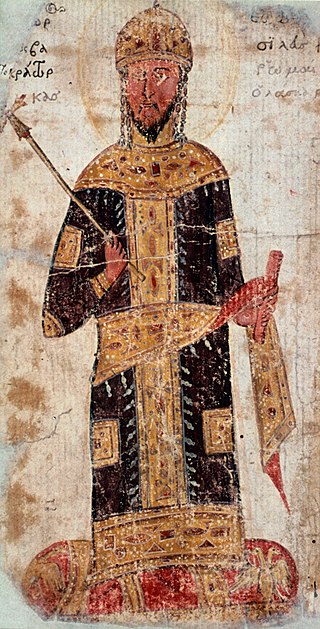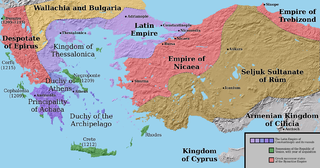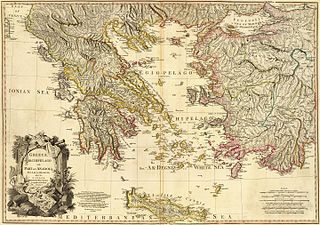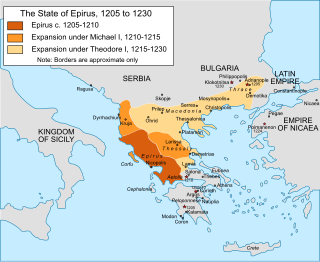
Theodore II Doukas Laskaris or Ducas Lascaris was Emperor of Nicaea from 1254 to 1258. He was the only child of Emperor John III Doukas Vatatzes and Empress Irene Laskarina. His mother was the eldest daughter of Theodore I Laskaris, who had established the Empire of Nicaea as a successor state to the Byzantine Empire in Asia Minor after the crusaders captured the Byzantine capital, Constantinople, during the Fourth Crusade in 1204. Theodore received an excellent education from two renowned scholars, Nikephoros Blemmydes and George Akropolites. He made friends with young intellectuals, especially with a page of low birth, George Mouzalon. Theodore began to write treatises on theological, historical and philosophical themes in his youth.

John III Doukas Vatatzes, Latinized as Ducas Vatatzes, was Emperor of Nicaea from 1221 to 1254. He was succeeded by his son, known as Theodore II Laskaris.

The Latin Empire, also referred to as the Latin Empire of Constantinople, was a feudal Crusader state founded by the leaders of the Fourth Crusade on lands captured from the Byzantine Empire. The Latin Empire was intended to replace the Byzantine Empire as the Western-recognized Roman Empire in the east, with a Catholic emperor enthroned in place of the Eastern Orthodox Roman emperors. The main objective to form a Latin Empire was planned over the course of the Fourth Crusade, promoted by crusade leaders such as Boniface of Montferrat, as well as the Republic of Venice.
The Battle of Pelagonia or Battle of Kastoria took place in early summer or autumn 1259, between the Empire of Nicaea and an anti-Nicaean alliance comprising Despotate of Epirus, Kingdom of Sicily and the Principality of Achaea. It was a decisive event in the history of the Eastern Mediterranean, ensuring the eventual reconquest of Constantinople and the end of the Latin Empire in 1261.

William of Villehardouin was the fourth prince of Achaea in Frankish Greece, from 1246 to 1278. The younger son of Prince Geoffrey I, he held the Barony of Kalamata in fief during the reign of his elder brother Geoffrey II. William ruled Achaea as regent for his brother during Geoffrey's military campaigns against the Greeks of Nicaea, who were the principal enemies of his overlord, the Latin Emperor of Constantinople Baldwin II. William succeeded his childless brother in the summer of 1246. Conflicts between Nicaea and Epirus enabled him to complete the conquest of the Morea in about three years. He captured Monemvasia and built three new fortresses, forcing two previously autonomous tribes, the Tzakones and Melingoi, into submission. He participated in the unsuccessful Egyptian crusade of Louis IX of France, who rewarded him with the right to issue currency in the style of French royal coins.

Theodore Komnenos Doukas or Theodore Angelos Komnenos was the ruler of Epirus and Thessaly from 1215 to 1230 and of Thessalonica and most of Macedonia and western Thrace from 1224 to 1230. He was also the power behind the rule of his sons John and Demetrios over Thessalonica in 1237–1246.
Alexios Komnenos Strategopoulos was a Byzantine aristocrat and general who rose to the rank of megas domestikos and Caesar. Distantly related to the Komnenian dynasty, he appears in the sources already at an advanced age in the early 1250s, leading armies for the Empire of Nicaea against Epirus. After falling out of favour and being imprisoned by Theodore II Laskaris, Strategopoulos sided with the aristocrats around Michael VIII Palaiologos, and supported him in his rise to the throne after Theodore II's death in 1258. He participated in the Pelagonia campaign in 1259, going on to capture Epirus, but his successes were undone in the next year and he was captured by the Epirotes. Released after a few months, he led the unexpected reconquest of Constantinople from the Latin Empire in July 1261, restoring the Byzantine Empire. He was captured again by the Epirotes in the next year and spent several years in captivity in Italy, before being released. He retired from public affairs and died in the early 1270s.

The Battle of Antioch on the Meander was a military engagement near Antioch-on-the-Meander between the forces of the Empire of Nicaea and the Seljuk Sultanate of Rûm. The Turkish defeat ensured continued Nicaean hegemony of the Aegean coast of Asia Minor. The Seljuk sultan, Kaykhusraw I, was killed on the field of battle. The battle took place near the modern town of Yamalak in Kuyucak district in Aydın Province.

The Frankokratia, also known as Latinokratia and, for the Venetian domains, Venetokratia or Enetokratia, was the period in Greek history after the Fourth Crusade (1204), when a number of primarily French and Italian states were established by the Partitio terrarum imperii Romaniae on the territory of the dismantled Byzantine Empire.

Golem was an Albanian nobleman who ruled the Principality of Arbanon, in its phase of semi-independency. He was the last ruler of Arbanon before its final annexation in the reemerging Byzantine Empire. His holdings included Krujë and probably Ohrid.
Manuel II was the Patriarch of Constantinople from 1244 to 1255. Because of the Latin occupation of Constantinople (1204–61), Manuel resided at the temporary Byzantine capital in Nicaea. He worked in close collaboration with Emperor John III Ducas Vatatzes, particularly in negotiations concerning possible union with the Roman Church. In 1249, Manuel II was likely involved with the delegation from Pope Innocent IV and led by the Franciscan friar John of Parma, which arrived at the temporary Patriarchal seat in Nymphaeum in 1249 and until 1250, there to debate the filioque against the Orthodox spokesman Nikephoros Blemmydes. The delegation from the Pope returned to him with a note from the Patriarch which exhorted unity under Christ as the only head of the Church, avoiding the term "Schism" and referring only to the "separation" of the Churches. In 1253, the Emperor and Manuel sent envoys to Pope Innocent IV to more formally discuss ecclesiastical union, renewing these negotiations. These were conducted in Perugia, and appear to have achieved some entente, with Innocent acknowledging the sincerity of the Orthodox Church's desire for union. Despite continued disagreement about the filioque clause in the Nicene Creed, negotiations continued, which resulted in an initial offer of formal recognition of the Greek patriarchate. No further progress was made after 1254, however, as the architects of the entente—Pope Innovent IV, the Emperor John Vatatzes, and the Patriarch Manuel II—all died within a few months of each other, and the impetus was lost.

The siege of Constantinople in 1260 was the failed attempt by the Nicene Empire, the major remnant of the fractured Byzantine Empire, to retake Constantinople from the Latin Empire and re-establish the City as the political, cultural and spiritual capital of a revived Byzantine Empire.

The Battle of Poimanenon or Poemanenum was fought in early 1224 between the forces of the two main successor states of the Byzantine Empire; the Latin Empire and the Byzantine Greek Empire of Nicaea. The opposing forces met at Poimanenon, south of Cyzicus in Mysia, near Lake Kuş.

John Gabalas was a Byzantine Greek magnate and hereditary ruler of the island of Rhodes in the 1240s. He lost control of the island to the Republic of Genoa in 1248, and called for aid from his suzerain, the Empire of Nicaea. Nicaean troops retook the island, but it was not restored to John's control, becoming a Nicaean province.
The Genoese occupation of Rhodes refers to the period between 1248 and late 1249/early 1250 during which the city of Rhodes and parts of the namesake island were under Genoese control. The Genoese took possession of the city and island, a dependency of the Empire of Nicaea, in a surprise attack in 1248, and held it, with aid from the Principality of Achaea, against Nicaean attacks until 1250.
Andronikos Komnenos Palaiologos, was a governor-general of Thessalonica and Grand domestic of the Empire of Nicaea. He was the father of the Byzantine emperor Michael VIII Palaiologos, the founder of the Palaeologue dynasty.
Andronikos Palaiologos was the son-in-law and heir-apparent of Theodore I Laskaris, Emperor of Nicaea, in the 1210s.

The Empire of Thessalonica is a historiographic term used by some modern scholars to refer to the short-lived Byzantine Greek state centred on the city of Thessalonica between 1224 and 1246 and ruled by the Komnenodoukas dynasty of Epirus. At the time of its establishment during the struggle for Constantinople, the Empire of Thessalonica, under the capable Theodore Komnenos Doukas, rivaled the Empire of Nicaea and the Second Bulgarian Empire as the strongest state in the region, and aspired to capturing Constantinople, putting an end to the Latin Empire, and restoring the Byzantine Empire that had been extinguished in 1204.

The struggle for Constantinople was a complex series of conflicts following the dissolution of the Byzantine Empire by the Fourth Crusade in 1204, fought between the Latin Empire established by the Crusaders, various Byzantine successor states, and foreign powers such as the Second Bulgarian Empire and Sultanate of Rum, for control of Constantinople and supremacy in the former empire's territory.
The Battle of Constantinople was a naval battle between the fleets of the Empire of Nicaea and the Republic of Venice that occurred in May–June 1241 near Constantinople.













